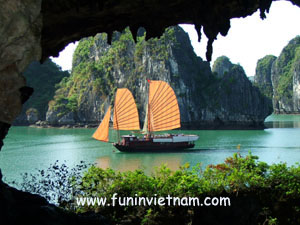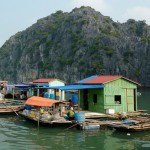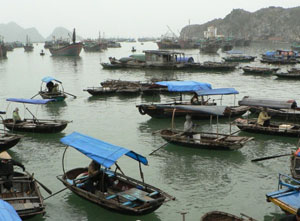
Junk boat cruises are a popular way to explore Ha Long Bay.
Halong Bay, known in Vietnam as Vịnh Hạ Long (Bay of the Descending Dragon), takes its name from the dragons which, legend holds, defended the area from Chinese invaders in ancient times and created the islets that fill the bay. This myth also gives names to nearby Bai Tu Long Bay and Bach Long Vy island. The eroded limestone geology of this area gives rise to the islands, caves, lakes, and rock formations that make Ha Long Bay a UNESCO World Heritage Site as well as a tourist favorite.
Striking white rock formations covered in dense jungle vegetation jut up from shimmering blue water. The islands and inlets of Ha Long Bay are noted for their abundance of caves and island lakes. With more than 3,000 tiny islands and quite a few larger ones, Ha Long is beautiful to behold — and full of opportunities for exploration and adventure.

No commute to work for these Ha Long Bay fishermen
Ha Long Bay and nearby Ha Long City offer plenty of sights and activities on the beaches and hills surrounding the bay, but many visitors can’t resist the allure of exploring Halong’s watery charms. Kayak tours are a great way to see the smaller islands and rocks “up close and personal,” and junk boat cruises offer a less intimate (but more luxurious) experience of the bay’s unique features.
There is a very active fishing culture here, as you can see from the many boats and even “floating villages” that exist in Ha Long Bay. Local fishermen are also increasingly practicing aquaculture to increase their yields and reduce pressure on the bay’s native fish stocks. Many exotic fish live in the bay, and Ha Long Bay’s mangrove forests shelter diverse wildlife of all types.
In addition to its value as a fishery and travel destination, the Halong Bay region will also benefit from a highway connecting Ha Long, Mong Cai, and Quang Ninh along the main road to southern China.

Fishing boats near shore in Ha Long Bay